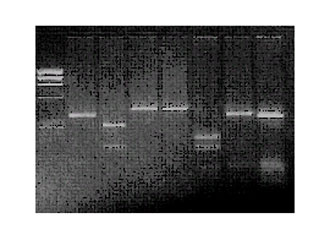From a total of 800 analyzed samples, 290 tested positive for the presence of the HPV infection. The type of the virus was determined in 190 samples (Table 1), while in 90 samples (29.6%) the HPV type remained unknown due to insufficient material and/or low viral load with uncommon HPV types. The most frequent type was HPV 16 (28.4%), followed by HPV 31 (12.1%), HPV 66var (7.9%), HPV 6 (7.4%), HPV 58 (6.8%), HPV 33 (5.2%) and HPV 18 (4.7%). Thirteen other HPV types (53, CP8304, 11, MM7, LVX160, 56, 61, 39, 54, 62, MM8, MM9 and LVX100) were detected with a frequency of 14.2%, while double and triple HPV infections were detected with a frequency of 13.3%.
The HPV 66 variant was found to be the third most common HPV type among Macedonian women. HPV 66 in our group of patients differs from the published HPV 66 type in one restriction enzyme site (RsaI) and was named the HPV 66var. The 450 bp MY09/ MY11 fragment of the HPV 66 type contains no RsaI restriction enzyme site, while the HPV 66var contains one RsaI site. The RsaI digestion of the 450 bp fragment of HPV 66var generates two fragments of ~380 and ~70 bp (Fig. 1). The nucleotide sequence of the MY09/MY11 DNA fragment of HPV 66var in comparison with the published HPV 66 sequence (GeneBank Acc No U31794) is shown in Figure 2. The DNA sequence analysis of this region showed only eight nucleotide differences between this variant and the published HPV 66 MY09/MY11 sequence, that is <2%, thus confirming that this virus is a variant of HPV type 66. One of these nucleotide changes creates an RsaI restriction enzyme site at position 72 bp from the 5' end of the MY09/ 11 fragment.
Cytological/histological findings in Macedonian women infected with a variant of HPV type 66 are shown in Table 2. Cervical cytology was performed in all 15 women, and biopsy specimens were taken from eight women. The results from the cytological and/or histological analyses showed that the HPV 66 was present in two women with normal cervical findings, one with nonspecific chronic cervical inflammation, seven with low-grade SIL and five with high-grade SIL.
In conclusion, a variant of HPV 66 is a relatively common type among Macedonian women with cervical abnormalities. It can be considered as an intermediate risk HPV type since it has been detected both in women with low- and high-grade SIL. The fact that some uncommon HPV types are relatively frequent in certain populations, such as HPV 66 among Macedonians, should be taken into consideration when designing an HPV detection protocol.
Table 1. HPV types detected among Macedonian women with cervical abnormalities
HPV Type |
n |
% |
16 |
54 |
28.4 |
31 |
23 |
12.1 |
66 |
15 |
7.9 |
6 |
14 |
7.4 |
58 |
13 |
6.8 |
33 |
10 |
5.2 |
18 |
9 |
4.7 |
Other types* |
27 |
14.2 |
>2 HPV types |
25 |
13.3 |
Total |
190 |
100.0 |
* HPVs 53, CP8304, 11, MM7, LVX160, 56, 61, 39, 54, 62, MM8, MM9 and LVX100.
Table 2. Cytologica/histological findings in women infected with a variant of the HPV type 66
Cytological/Histological Findings |
n |
% |
Normal cervical findings |
2 |
13.3 |
Non-specific chronic inflammation |
1 |
6.7 |
Low-grade SIL |
7 |
46.7 |
High-grade SIL |
5 |
33.3 |
Total |
15 |
100.0 |
Figure 1. RFLP pattern of the MY09/MY11 PCR fragment of the HPV 66var. L: ladder (DNA molecular weight marker IX; Boehringer Mannheim, Mannheim, Germany); B: BamHI (366 + 83 bp); D: DdeI (291 + 158 bp); H: HaeIII (449 bp); Hi: HinfI (449 bp); P: PstI (207 + 150 +66 +26 bp); R: RsaI (~380 +~70 bp); S: SauAI (366 + 63 + 20 bp).

HPV66 gcacagggcc ataataatgg catatgctgg ggtaatcagg tatttgttac tgttgtggat
HPV66var gcacagggcc ataataatgg catatgctgg ggtaatcagg tatttgttac tgttgtggat
HPV66 actaccagaa gcaccaacat gactattaat gcagctaaaa gcacattaac taaatatgat
HPV66var actaccagaa gtaccaacat gactattaat gcagctaaaa gcacattaac taaatatgat
RsaI
HPV66 gcccgtgaaa tcaatcaata ccttcgccat gtggaggaat atgaactaca gtttgtgttt
HPV66var gcacgtgaaa tcaatcaata ccttcgccat gtggaggaat atgaactaca gtttgtgttt
HPV66 caactttgta aaataacctt aactgcagaa gttatggcat atttgcataa tatgaataat
HPV66var caactttgta aaataacctt aactgcagaa gttatggcat atttgcataa tatgaataat
HPV66 actttattag acgattggaa tattggctta tccccaccag ttgcaactag cttagaggat
HPV66var actttattag acgattggaa cattggattg tccccaccag ttgcaactag cttagaggat
HPV66 aaatataggt atattaaaag cacagctatt acatgtcaga gggaacagcc ccctgcagaa
HPV66var aaatataggt atattaaaag cacagctatt acatgtcaaa gggaacagcc ccctgcagaa
HPV66 aagcaggatc ccctggctaa atataagttt tgggaagtta atttacagga cagcttttct
HPV66var aagcaggatc ccctggctaa atataagttt tgggaggtta atttacagga cagcttttct
HPV66 gcagacctgg atcagtttcc tttgggtag
HPV66var gcagacctag atcagtttcc tttgggtag
Figure 2. Nucleotide sequence of the MY09/MY11 DNA fragment of the HPV 66var compared to the published HPV 66 sequence.

